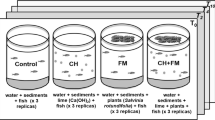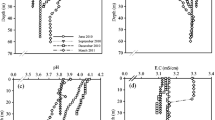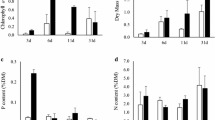Abstract
The utilization of periphyton activity for the removal of heavy metals from enriched small streams has been examined. By means of short-term batch laboratory experiments the courses of metal uptake have been studied. For uptake study naturally growing periphyton community and periphytic filamentous algae Cladophora glomerata and Oedogonium rivulare have been used. Uptakes of nine heavy metals — Pb, Cd, Cu, Co, Cr, Ni, Zn, Fe and M n — have been determined during four hours' exposure. In addition the influence of humic substances on heavy metals uptake has been determined.
Uptake of all metals increased during four hours' exposure but not in the same way. Some metals were removed continuously (Ni, Cr, Fe and Mn), other metals were removed more rapidly during the first hour or first two hours of exposure and then only slight removal continued (Cu, Pb, Cd, Co). Uptake of Zn was rather unambiguous. Results of these experiments suggest that the course of uptake for individual metals could be similar for most periphyton algae.
It was established that humic substances significantly reduce heavy metals uptake. The highest decrease of uptake was observed in Cu, Cr, Co and Cd.
The results of model experiments are being tested in a pilot scale with respect to the demands of engineering practice.
Similar content being viewed by others
References
Allen, H. E., 1976. Metal speciation in aquatic environments. Proc. Workshop on Toxicity to Biota of Metal Forms in Natural Waters. Duluth, Minnesota: 33–57.
Allen, H. E., R. M. Hall & T. D. Brisbin, 1980. Metal speciation. Effect on aquatic toxicity. Envir. Sci. Technol. 14: 441–443.
Anderson, D. M. & F. M. M. Morel, 1978. Copper sensitivity to Gonyaulax tamarensis. Limnol. Oceanogr. 23: 283–295.
Bachmann, R. W., 1963. Zinc-65 studies of the freshwater zinc cycle. In V. Schultz & A. W. Klement (eds.), Radioecology. Reinhold Publ., Corp., N.Y.: 485–496.
Blum, J. L., 1956. The ecology of river algae. Bot. Rev. 22: 291–341.
Cushing, C. E. & D. G. Watson, 1968. Accumulation of 32P and 65Zn by living and killed plankton. Oikos 19: 143–145.
Cushing, C. E. & F. L. Rose, 1970. Cycling of zinc-65 by Columbia river periphyton in closed lotic microcosm. Limnol. Oceanogr. 15: 762–767.
Florence, T. T., 1977. Trace metal species in fresh water. Wat. Res. 11: 681–687.
Getz, L. L., A. W. Haney, R. W. Larimore, J. W. Mc Nurney, H. V. Leland, P. W. Price, G. L. Rolfe, R. L. Wortman, J. L. Hudson, R. L. Solomon & K. A. Reinhold, 1977. Transport and distribution in a watershed ecosystem. In W. R. Bogges & B. G. Winxon (eds.), Lead in the Environment. NSF. Rep. R A 770214: 105–133.
Gjessing, E. T., 1967. Humic substances in natural waters: method for separation and characterization. In H. L. Golterman & R. S. Clymo (eds.), Chemical Environment in the Aquatic Habitat. North-Holland, Amsterdam: 191–201.
Gjessing, T. E., 1976. Physical and Chemical Characteristic of Aquatic Humus. Ann Arbor Science Publishers, Inc., Ann Arbor, Mich., U.S.A. 120 pp.
Greene, J. C., W. E. Miller, T. Shiroyama & E. Merwin, 1973. Toxicity of Zinc to Green Alga Selenastrum capricornutum as a Function of Phosphorus or Ionic Strength. Proc. Biostimul. Nutr. Ass. Workshop. U.S.EPA 660/3-73-034:28–43.
Greenfield, S. S., 1942. Inhibitory effect of inorganic compounds on photosynthesis of Chlorella. Am. J. Bot. 29: 121–131.
Gutknecht, J., 1961. Mechanism of radioactive zinc uptake by Ulva lactuca. Limnol. Oceanogr. 6: 426–431.
Gutknecht, J., 1963. Zn-65 uptake by benthic marine algae. Limnol. Oceanogr. 8: 31–38.
Gutknecht, J., 1965. Uptake and retention of cesium 137 and zinc 65 by seaweeds. Limnol. Oceanogr. 10: 58–66.
Huntsman, S. A. & W. G. Sunda, 1981. The role of trace metals in regulating phytoplankton growth. In J. Morris (ed.), The Physiological Ecology of Phytoplankton. Studies in Ecology, 7, Blackwell Sciences Publ.: 285–328.
Keeney, W. L., W. G. Breck, G. W. Van Loon & J. A. Page, 1976. The determination of trace metals in Cladophora glomerata. C. glomerata as a potential biological monitor. Wat. Res. 10: 981–984.
Kemp, A. L. W. & A. Mudrochova, 1973. The distribution and nature of amino acids and other nitro-containing compounds in Lake Ontario surface sediments. Geol. Cosmochim. Acta 37: 191–201.
Kemp, A. L. W. & H. K. T. Wong, 1974. Molecular-weight distribution of humic substances from lakes Ontario and Erie sediments. Chem. Geol. 14: 15–22.
Leland, H. V., S. N. Luoma, J. F. Elder & D. J. Wilkes, 1978. Heavy metals and related trace elements. J. Wat. Pollut. Cont. Fed. 50: 1469–1514.
Mantoura, R. F. C., A. Dickson & J. P. Riley, 1978. The complexation of metals with humic materials in nature waters. Estuar. coast mar. Sci. 6: 387–408.
Marvan, P., S. Přibil, A. Sládečková & Z. Žáková 1981. Proposal of a standard method for the determination of the trophic potential of water. Wat. Mgmt B 31: 5–8 (in Czech).
Ramamoorthy, S. & D. J. Kushner, 1975. Heavy metal binding components of river water. J. Fish. Res. Bd Can. 32: 1755–1766.
Rashid, M. A., 1971. Role of humic acids of marine origin and their different molecular weight fractions in complexing diand tri-valent metals. Soil Sci. 111: 298–306.
Rashid, M. A., 1974. Absorption of metals on sedimentary and peat humic acids. Chem. Geol. 13: 115–122.
Rashid, M. A. & L. A. King, 1969. Molecular weight distribution measurements on humic and fulvic acid fraction from marine clays on the Scotian Shelf. Geochim. Cosmochim. Acta 33: 147–151.
Say, P. J. & B. A. Whitton, 1981. Chemistry and plant ecology of zinc-rich streams in Northern Pennines. In P. J. Say & B. A. Whitton (eds.), Heavy Metals in Northern England: Environmental and Biological Aspects. Univ. Durham, Durham: 55–63.
Sedláček, J., T. Källquist & E. T. Gjessing, 1983. Effect of aquatic humus on uptake and toxicity of cadmium to Selenastrum capricornutum. In R. F. Christman & E. T. Gjessing (eds.), Aquatic and Terrestrial Humic Materials. Ann Arbor Science Publishers, Ann Arbor, Mich., U.S.A.: 495–516.
Sládečková, A., P. Marvan & J. Vymazal, 1983. The utilization of periphyton in waterworks pre-treatment for nutrient removal from enriched influents. Dev. Hydrobiol. 17: 299–303.
Steemann Nielsen, E. & L. Kamp-Nielsen, 1970. Influence of deleterious concentrations of copper on the growth of Chlorella perenoidosa. Physiol. Pl. 23: 828–840.
Steemann Nielsen, E. & S. Wium-Andersen, 1970. Copper ions as poison in the sea and in freshwater. Mar. Biol. 6: 93–97.
Steemann Nielsen, E., L. Kamp-Nielsen & S. Wium-Andersen, 1969. The effect of deleterious concentrations of copper on the phytoplankton. Physiol. Pl. 22: 1121–1133.
Sunda, W. G. & R. R. L. Guillard, 1976. The relationship between cupric ion activity and the toxicity of copper to phytoplankton. J. mar. Res. 34: 511–529.
Trollope, D. R. & B. Evans, 1976. Concentrations of copper, iron, lead, nickel and zinc in freshwater algal blooms. Envir. Pollut. 11: 109–116.
Weber, J. H. & S. A. Wilson, 1975. The isolation and characterization of fulvic and humic acid from river water. Wat. Res. 9: 1079–1084.
Whitton, B. A. & B. M. Diaz, 1980. Chemistry and plants of streams and rivers with elevated zinc. In D. D. Hemphill (ed.), Trace Substances in Environmental Health—XIV. Symp., Univ. Missouri, Columbia: 457–463.
Whitton, B. A., P. J. Say & J. D. Wehr, 1981. Use of plants to monitor heavy metals in rivers. In P. J. Say & B. A. Whitton (eds.), Heavy Metals in Northern England: Environmental and Biological Aspects. Univ. Durham, Durham: 135–145.
Wong, P. T., Y. K. Chau & P. L. Luxon, 1978. Toxicity of a mixture of metals on freshwater algae. J. Fish. Res. Bd Can. 35: 479–481.
Young, R. G. & D. J. Lisk, 1972. Effect of copper and silver ions on algae. J. Wat. Pollut. Cont. Fed. 44: 1643–1648.
Author information
Authors and Affiliations
Rights and permissions
About this article
Cite this article
Vymazal, J. Short-term uptake of heavy metals by periphyton algae. Hydrobiologia 119, 171–179 (1984). https://doi.org/10.1007/BF00015208
Received:
Accepted:
Issue Date:
DOI: https://doi.org/10.1007/BF00015208




